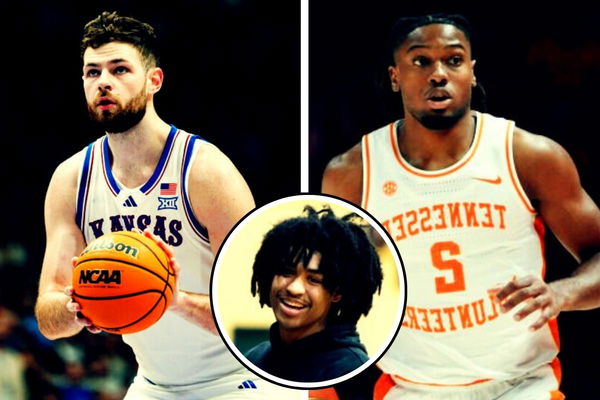

Just as in basketball, in the game of Name, Image, and Likeness (NIL) valuations, fortunes rise and fall as swiftly as a buzzer-beater shot. This year, players like Hunter Dickinson, Dylan Harper, and Chaz Lanier, who became the mainstays of the NIL world, saw their valuations drop. On the other hand, Villanova’s Eric Dixon has surged ahead, setting a new benchmark. The numbers tell the story, but the dynamics behind them reveal the ever-changing landscape of collegiate basketball.
Hunter Dickinson, the Kansas Jayhawks’ centerpiece, has endured the steepest NIL drop of the season. His valuation plummeted by $214,000 to $1.5 million after the Jayhawks slipped from the top spot in the AP college men’s basketball rankings since Week 6.
Once celebrated for his dominance in the post, Dickinson has faced growing criticism, labeled as a liability on defense and a limited threat from beyond the arc. Despite averaging 16.0 points on 55.4% shooting from the field with 10.3 rebounds this season, his performance hasn’t been enough to stave off doubts. Now ranked No. 44 in NIL standings, his decline reflects the harsh reality that even solid statistics can’t always counter shifting perceptions.
ADVERTISEMENT
Article continues below this ad
Meanwhile, Eric Dixon of Villanova is enjoying the spotlight. His stellar season, highlighted by a league-leading 25.7 points per game on 51.6% shooting, has catapulted his NIL valuation to $1.9 million—a remarkable $623,000 increase. Currently ranked No. 29, Dixon’s rise is a testament to his ability to anchor his team with consistent offensive brilliance.
In fact, Dixon has shown that the court isn’t just a stage; it’s a proving ground where numbers and leadership coalesce. The tale isn’t as rosy for other notable names.
Hunter Dickinson’s NIL dips: Rising stars face tough realities
Memphis Tigers’ PJ Haggerty, despite his impressive 22.2 points per game (ranked fifth overall), saw a $79,000 drop in NIL valuation, settling at $1.7 million. Maxime Raynaud, Stanford’s towering force, experienced a similar decline of $147,000 to $1.5 million after his team suffered three consecutive losses straddling the end of 2024 and the start of 2025. His double-double averages of 20.9 points (10th) and 11.4 rebounds (3rd) couldn’t shield him from the consequences of team struggles.
ADVERTISEMENT
Article continues below this ad

USA Today via Reuters
Mar 9, 2024; Houston, Texas, USA; Kansas Jayhawks center Hunter Dickinson (1) reacts after a call during the first half against the Houston Cougars at Fertitta Center. Mandatory Credit: Troy Taormina-USA TODAY Sports
Dylan Harper of Rutgers, touted as one of the game’s next big stars, saw his valuation dip by $75,000 to $1.7 million, ranking him 33rd. His 21.1 points per game and decent playmaking (4.5 assists per game) still place him above his teammate, Ace Bailey, but the loss serves as a reminder that potential alone doesn’t secure NIL stability. Chaz Lanier of Tennessee also took a hit, dropping $82,000 to $1.7 million despite averaging 19.6 points per game, ranking 20th overall.
What’s your perspective on:
Is Hunter Dickinson's decline a sign of overrated hype, or can he bounce back stronger?
Have an interesting take?
These fluctuations highlight the unforgiving nature of NIL valuations, which are as much about perception and team performance as individual stats. For players like Dickinson, regaining momentum on the court could reverse the narrative, while Dixon’s trajectory underscores the value of clutch performances in high-stakes moments.
ADVERTISEMENT
Article continues below this ad
As the season progresses, the NIL scoreboard remains just as competitive as the one on the hardwood, with every play influencing the next valuation shift. In basketball and NIL alike, the game is never over until the final buzzer. Who will rebound and who will fade further? That’s the question hanging in the air as players fight to define their legacy—and their market worth.
ADVERTISEMENT
ADVERTISEMENT
ADVERTISEMENT
ADVERTISEMENT


Is Hunter Dickinson's decline a sign of overrated hype, or can he bounce back stronger?